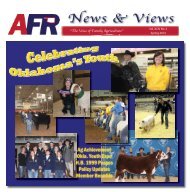Oklahoma Farmers Union - American Farmers & Ranchers
Oklahoma Farmers Union - American Farmers & Ranchers
Oklahoma Farmers Union - American Farmers & Ranchers
Create successful ePaper yourself
Turn your PDF publications into a flip-book with our unique Google optimized e-Paper software.
“Meeting the Insurance Mission”<br />
In 1919 delegates to the OFU state convention directed the organization to form<br />
the <strong>Oklahoma</strong> <strong>Farmers</strong> <strong>Union</strong> Mutual Fire and Lightning Insurance Company to serve<br />
rural areas in covering farm buildings, household goods, farm implements, farm products<br />
and livestock. A tornado clause and a death benefit were added later.<br />
Using its’ political strength, the organization secured passage of a law that<br />
enabled a farm organization to insure the properties of its’ members without capital or<br />
outside control by the Commission of Insurance. The legislation meant that the <strong>Union</strong><br />
could make its own rules, fix its own rates, and settle its own losses.<br />
Z.H. “Zed” Lawter, OFU President John Simpson’s neighbor and <strong>Farmers</strong> <strong>Union</strong><br />
member in Custer County, moved to <strong>Oklahoma</strong> City to take charge of the newly formed<br />
insurance company. Before being chartered, however, Lawter had to find 1,000 members<br />
who would apply for a policy, and no policy could be less than $500. With only 284<br />
policyholders the company began January 1922 and was delivered through the farm<br />
network of local organization secretaries.<br />
Each agent received a policy fee of $1.00; plus, upon delivery of the policy a<br />
further fee of twenty-five cents per $100 of its face value. It was a small sum, but the<br />
agents worked hard and by 1921 the membership rolls for the state were 23,000.<br />
Coverage of Mr. W.A. Stone of Byars for $675 of coverages for his home,<br />
livestock and equipment in January 1922 cost $4.35 and provided coverage for five years.<br />
His policy number was 69.<br />
As time passed more coverages were offered by company policies. A tornado<br />
clause was soon added, followed a few years later by a death benefit policy. Simpson<br />
calling the latter program “Helpers,” introduced a plan to provide up to $200 in burial<br />
expenses at a cost of ten cents for each member of a family. The “Helpers” plan moved<br />
slowly in the beginning, but Simpson’s continuous pleading and cajoling got the program<br />
underway.<br />
The unusual luck that several years passed before a loss had to be paid assuredly<br />
helped the plan survive. The “Helpers” listed <strong>Oklahoma</strong> Congressmen Jed Johnson, Will<br />
Rogers and Wilburn Cartwright all as participants in 1940. Over time members were<br />
assessed when a member died to assist the families but this voluntary effort would<br />
ultimately cause the demise of the effort when members failed to send their contributions.<br />
The first beneficiary did not actually receive the full $200. On February 27, 1922,<br />
the family of W.A. Townsend of Broken Bow, who died at the age of eighty-six became<br />
the first recipient of the death benefit clause. At the time only 243 members had<br />
registered, which meant that the family was paid $24.30, the total fund in the treasury.<br />
State officers added another seventy-five cents to the amount.<br />
The first loss for the Mutual company came only a few months later. Brother Ed<br />
Roesley of the Cottonwood Local, No. 298 in Custer County filed the first claim when a



